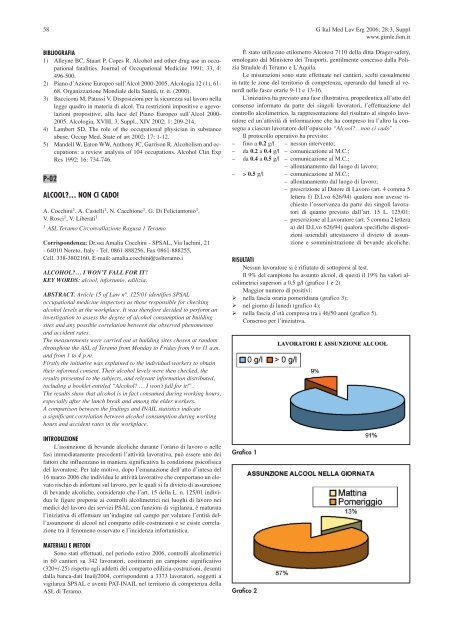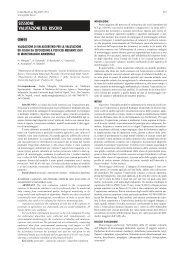Indice - Giornale Italiano di Medicina del Lavoro ed Ergonomia ...
Indice - Giornale Italiano di Medicina del Lavoro ed Ergonomia ...
Indice - Giornale Italiano di Medicina del Lavoro ed Ergonomia ...
You also want an ePaper? Increase the reach of your titles
YUMPU automatically turns print PDFs into web optimized ePapers that Google loves.
58 G Ital M<strong>ed</strong> Lav Erg 2006; 28:3, Suppl<br />
www.gimle.fsm.it<br />
BIBLIOGRAFIA<br />
1) Alleyne BC, Stuart P, Copes R. Alcohol and other drug use in occupational<br />
fatalities. Journal of Occupational Me<strong>di</strong>cine 1991; 33, 4:<br />
496-500.<br />
2) Piano d’Azione Europeo sull’Alcol 2000-2005, Alcologia 12 (1), 61-<br />
68. Organizzazione Mon<strong>di</strong>ale <strong>del</strong>la Sanità, tr. it. (2000).<br />
3) Bacciconi M, Patussi V. Disposizioni per la sicurezza sul lavoro nella<br />
legge quadro in materia <strong>di</strong> alcol. Tra restrizioni impositive e agevolazioni<br />
propositive, alla luce <strong>del</strong> Piano Europeo sull’Alcol 2000-<br />
2005. Alcologia, XVIII, 3, Suppl., XIV 2002; 1: 209-214,<br />
4) Lambert SD. The role of the occupational physician in substance<br />
abuse. Occup M<strong>ed</strong>, State of art 2002; 17: 1-12.<br />
5) Man<strong>del</strong>l W, Eaton WW, Anthony JC, Garrison R. Alcoholism and occupations:<br />
a review analysis of 104 occupations. Alcohol Clin Exp<br />
Res 1992; 16: 734-746.<br />
P-02<br />
ALCOOL?… NON CI CADO!<br />
A. Cocchini1 , A. Castelli1 , N. Cacchione1 , G. Di Feliciantonio1 ,<br />
V. Rosci1 , V. Liberati1 1 ASL Teramo Circonvallazione Ragusa 1 Teramo<br />
Corrispondenza: Dr.ssa Amalia Cocchini - SPSAL, Via Iachini, 21<br />
- 64010 Nereto, Italy - Tel. 0861-888256, Fax 0861-888255,<br />
Cell. 338-3802160, E-mail: amalia.cocchini@aslteramo.i<br />
ALCOHOL?… I WON’T FALL FOR IT!<br />
KEY WORDS: alcool, infortunio, e<strong>di</strong>lizia.<br />
ABSTRACT. Article 15 of Law n°. 125/01 identifies SPSAL<br />
occupational me<strong>di</strong>cine inspectors as those responsible for checking<br />
alcohol levels at the workplace. It was therefore decid<strong>ed</strong> to perform an<br />
investigation to assess the degree of alcohol consumption at buil<strong>di</strong>ng<br />
sites and any possible correlation between the observ<strong>ed</strong> phenomenon<br />
and accident rates.<br />
The measurements were carri<strong>ed</strong> out at buil<strong>di</strong>ng sites chosen at random<br />
throughout the ASL of Teramo from Monday to Friday from 9 to 11 a.m.<br />
and from 1 to 4 p.m.<br />
Firstly the initiative was explain<strong>ed</strong> to the in<strong>di</strong>vidual workers to obtain<br />
their inform<strong>ed</strong> consent. Their alcohol levels were then check<strong>ed</strong>, the<br />
results present<strong>ed</strong> to the subjects, and relevant information <strong>di</strong>stribut<strong>ed</strong>,<br />
inclu<strong>di</strong>ng a booklet entitl<strong>ed</strong> “Alcohol? … I won’t fall for it!”.<br />
The results show that alcohol is in fact consum<strong>ed</strong> during working hours,<br />
especially after the lunch break and among the elder workers.<br />
A comparison between the fin<strong>di</strong>ngs and INAIL statistics in<strong>di</strong>cate<br />
a significant correlation between alcohol consumption during working<br />
hours and accident rates in the workplace.<br />
INTRODUZIONE<br />
L’assunzione <strong>di</strong> bevande alcoliche durante l’orario <strong>di</strong> lavoro o nelle<br />
fasi imme<strong>di</strong>atamente prec<strong>ed</strong>enti l’attività lavorativa, può essere uno dei<br />
fattori che influenzano in maniera significativa la con<strong>di</strong>zione psicofisica<br />
<strong>del</strong> lavoratore. Per tale motivo, dopo l’emanazione <strong>del</strong>l’atto d’intesa <strong>del</strong><br />
16 marzo 2006 che in<strong>di</strong>vidua le attività lavorative che comportano un elevato<br />
rischio <strong>di</strong> infortuni sul lavoro, per le quali si fa <strong>di</strong>vieto <strong>di</strong> assunzione<br />
<strong>di</strong> bevande alcoliche, considerato che l’art. 15 <strong>del</strong>la L. n. 125/01 in<strong>di</strong>vidua<br />
le figure preposte ai controlli alcolimetrici nei luoghi <strong>di</strong> lavoro nei<br />
me<strong>di</strong>ci <strong>del</strong> lavoro dei servizi PSAL con funzioni <strong>di</strong> vigilanza, è maturata<br />
l’iniziativa <strong>di</strong> effettuare un’indagine sul campo per valutare l’entità <strong>del</strong>l’assunzione<br />
<strong>di</strong> alcool nel comparto e<strong>di</strong>le-costruzioni e se esiste correlazione<br />
tra il fenomeno osservato e l’incidenza infortunistica.<br />
MATERIALI E METODI<br />
Sono stati effettuati, nel periodo estivo 2006, controlli alcolimetrici<br />
in 60 cantieri su 342 lavoratori, costituenti un campione significativo<br />
(320+/-25) rispetto agli addetti <strong>del</strong> comparto e<strong>di</strong>lizia-costruzioni, desunti<br />
dalla banca-dati Inail/2004, corrispondenti a 3373 lavoratori, soggetti a<br />
vigilanza SPSAL e aventi PAT-INAIL nel territorio <strong>di</strong> competenza <strong>del</strong>la<br />
ASL <strong>di</strong> Teramo.<br />
È stato utilizzato etilometro Alcotest 7110 <strong>del</strong>la <strong>di</strong>tta Drager-safety,<br />
omologato dal Ministero dei Trasporti, gentilmente concesso dalla Polizia<br />
Stradale <strong>di</strong> Teramo e L’Aquila.<br />
Le misurazioni sono state effettuate nei cantieri, scelti casualmente<br />
in tutte le zone <strong>del</strong> territorio <strong>di</strong> competenza, operando dal lun<strong>ed</strong>ì al venerdì<br />
nelle fasce orarie 9-11 e 13-16.<br />
L’iniziativa ha previsto una fase illustrativa, prop<strong>ed</strong>eutica all’atto <strong>del</strong><br />
consenso informato da parte dei singoli lavoratori, l’effettuazione <strong>del</strong><br />
controllo alcolimetrico, la rappresentazione <strong>del</strong> risultato al singolo lavoratore<br />
<strong>ed</strong> un’attività <strong>di</strong> informazione che ha compreso tra l’altro la consegna<br />
a ciascun lavoratore <strong>del</strong>l’opuscolo “Alcool?…non ci cado”.<br />
Il protocollo operativo ha previsto:<br />
– fino a 0.2 g/l – nessun intervento;<br />
– da 0.2 a 0.4 g/l – comunicazione al M.C.;<br />
– da 0.4 a 0.5 g/l – comunicazione al M.C.;<br />
– allontanamento dal luogo <strong>di</strong> lavoro;<br />
– > 0.5 g/l – comunicazione al M.C.;<br />
– allontanamento dal luogo <strong>di</strong> lavoro;<br />
– prescrizione al Datore <strong>di</strong> <strong>Lavoro</strong> (art. 4 comma 5<br />
lettera f) D.Lvo 626/94) qualora non avesse richiesto<br />
l’osservanza da parte dei singoli lavoratori<br />
<strong>di</strong> quanto previsto dall’art. 15 L. 125/01;<br />
– prescrizione al Lavoratore (art. 5 comma 2 lettera<br />
a) <strong>del</strong> D.Lvo 626/94) qualora specifiche <strong>di</strong>sposizioni<br />
aziendali attestassero il <strong>di</strong>vieto <strong>di</strong> assunzione<br />
e somministrazione <strong>di</strong> bevande alcoliche.<br />
RISULTATI<br />
Nessun lavoratore si è rifiutato <strong>di</strong> sottoporsi al test.<br />
Il 9% <strong>del</strong> campione ha assunto alcool, <strong>di</strong> questi il 19% ha valori alcolimetrici<br />
superiori a 0.5 g/l (grafico 1 e 2)<br />
Maggior numero <strong>di</strong> positivi:<br />
nella fascia oraria pomeri<strong>di</strong>ana (grafico 3);<br />
nel giorno <strong>di</strong> lun<strong>ed</strong>ì (grafico 4);<br />
nella fascia d’età compresa tra i 46/50 anni (grafico 5).<br />
Consenso per l’iniziativa.<br />
Grafico 1<br />
Grafico 2
















